 | ||||||||||||||||||||||
| Sinterklaas arrives by boat in Leiden Whilst the work on the handscrolls continues it is against the colorful backdrop of the Festival of Sinterklaas which is celebrated throughout Belgium and Holland. Although originally from Turkey and dating from 280-342 AD, St Nicholas is the patron saint of sailors and children. The modern tradition of Sinterklaas as a children's feast dates from a childrens storybook written in 1850 by the teacher Jan Schenkman. He introduced the images of Sinterklaas delivering presents down the chimney, riding over the roofs of houses on a gray horse, and arriving from Spain by steamboat, then an exciting modern invention. Sinterklaas is assisted by many mischievous helpers with black faces and colourful Moorish dresses. These helpers are called 'Zwarte Pieten' (Black Petes). During the Middle-ages Zwarte Piet was a name for the devil.. Today however, the more politically correct explanation that Pete's face is "black from soot" (as Pete has to climb down chimneys to deliver his gifts) is used. In medieval times, the feast was both an occasion to help the poor, by putting money in their shoes (which evolved into putting presents in children's shoes). Whilst good children are rewarded with presents, naughty children are threatened with being kidnapped and carried back to Spain. |
 | |||
| Two especially dubious 'Black Piet's' |












